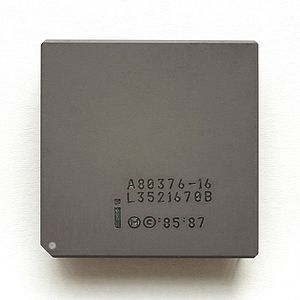80386 range processors
80386DX
- Introduced October 17, 1985
- Clock rates:
- 16 MHz with 5 to 6 MIPS
- 20 MHz with 6 to 7 MIPS, introduced February 16, 1987
- 25 MHz with 8.5 MIPS, introduced April 4, 1988
- 33 MHz with 11.4 MIPS (9.4 SPECint92 on Compaq/i 16K L2), introduced April 10, 1989
- Bus Width 32 bit data, 32 bit address
- Number of Transistors 275,000 at 1 µm
- Addressable memory 4 GB (4 GB)
- Virtual memory 64 TB (64 TiB)
- First x86 chip to handle 32-bit data sets
- Reworked and expanded memory protection support including paged virtual memory and virtual-86 mode, features required at the time by Xenix and Unix. This memory capability spurred the development and availability of OS/2 and is a fundamental requirement for modern operating systems like Linux, Vista, and MacOS.
- Used in Desktop computing
80960 (i960) (chronological entry)
- Introduced April 5, 1988
- See main entry
80386SX
- Introduced June 16, 1988
- Clock rates:
- 16 MHz with 2.5 MIPS
- 20 MHz with 2.5 MIPS, introduced January 25, 1989
- 25 MHz with 2.7 MIPS, introduced January 25, 1989
- 33 MHz with 2.9 MIPS, introduced October 26, 1992
- Internal architecture 32 bits
- External data bus width 16 bits
- External address bus width 24 bits
- Number of Transistors 275,000 at 1 µm
- Addressable memory 16 MB
- Virtual memory 32 GB
- Narrower buses enable low-cost 32-bit processing
- Used in entry-level desktop and portable computing
- No Math Co-Processor
- No commercial Software used for protected mode or virtual storage for many years
80376
- Introduced January 16, 1989; Discontinued June 15, 2001
- Variant of 386SX intended for embedded systems
- No "real mode", starts up directly in "protected mode"
- Replaced by much more successful 80386EX from 1994
80860 (i860) (chronological entry)
- Introduced February 27, 1989
80486DX (chronological entry)
- Introduced April 10, 1989
80386SL
- Introduced October 15, 1990
- Clock rates:
- 20 MHz with 4.21 MIPS
- 25 MHz with 5.3 MIPS, introduced September 30, 1991
- Internal architecture 32 bits
- External bus width 16 bits
- Number of Transistors 855,000 at 1 µm
- Addressable memory 4 GB
- Virtual memory 1 TB
- First chip specifically made for portable computers because of low power consumption of chip
- Highly integrated, includes cache, bus, and memory controllers
80486SX/DX2/SL, Pentium, 80486DX4 (chronological entries)
- Introduced 1991–1994
80386EX
- Introduced August 1994
- Variant of 80386SX intended for embedded systems
- Static core, i.e. may run as slowly (and thus, power efficiently) as desired, down to full halt
- On-chip peripherals:
- Clock and power mgmt
- Timers/counters
- Watchdog timer
- Serial I/O units (sync and async) and parallel I/O
- DMA
- RAM refresh
- JTAG test logic
- Significantly more successful than the 80376
- Used aboard several orbiting satellites and microsatellites
- Used in NASA's FlightLinux project


0 Response to "80386 range processors"
Post a Comment